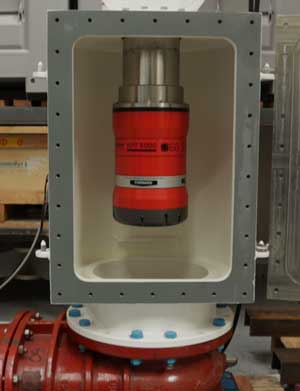Our SPRINT-Nav hybrid navigation instrument is helping to drive a growing move towards the use of resident ROV systems. We visited Norway-based IKM Subsea to find out more.
IKM Subsea has been taking a step-wise approach to resident subsea systems. After building its first all-electric remote operated vehicles (ROVs) in 2015, the company has gone on to introduce a subsea garage system from which their latest vehicles can operate.
Having vehicles based subsea has a number of benefits that more and more operators are seeing. As resident systems, deployed permanently, or semi-permanently subsea, vehicles can be on site, ready for action, 24/7, supported from onshore – reducing cost and increasing safety, operability, and productivity.
Resident ROVs
IKM Subsea’s resident ROV (R-ROV) concept is based on the firm’s 3,000 m-rated Merlin UCV ROV, which operates on a 1,000 m excursion capable tether management system (TMS) from a subsea “E-cage” (or garage). The E-cage is in turn wired to a host platform. Since late 2018, one of these systems has been operating on the seabed at operator Equinor’s Snorre B facility, offshore Norway. It’s available on demand, piloted from offshore and onshore (via a fiber optic link to the beach), on three-month long deployments. Between those deployments, it’s hauled to the surface, using the host facility’s crane, for maintenance.
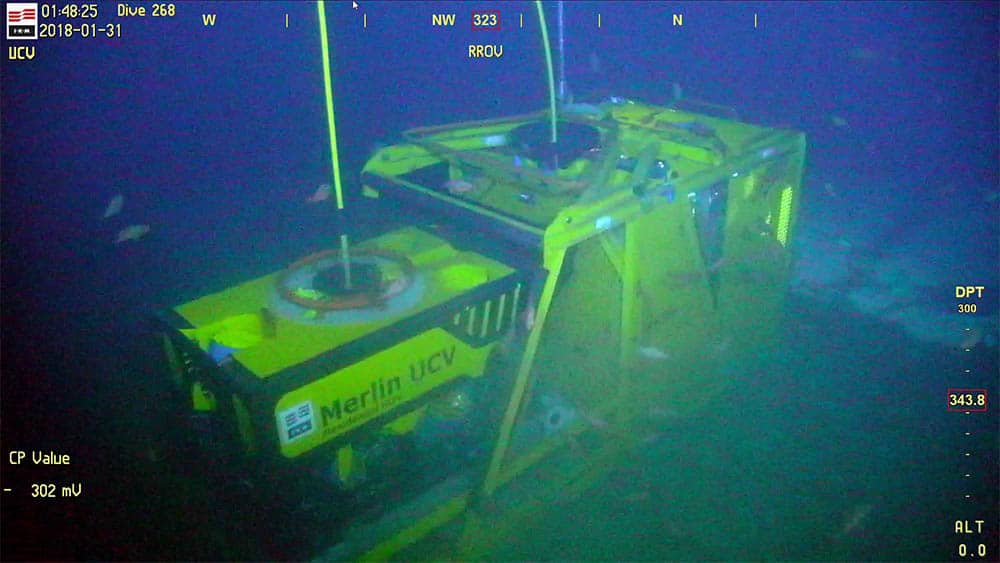
Enabling a subsea resident vehicle poses a number of challenges, from remote control functionality to reducing maintenance requirements. “A key requirement has also been station keeping, to help with certain tasks, when you need the ROV to be stationary,” says Ments Tore Møller, IKM Subsea’s Engineering Manager, “and as a backup mode of operation, if communication is lost. It’s also useful for path-follow mode, when the ROV can navigate itself.”
Compact hybrid navigation
For these capabilities, IKM Subsea looked to SPRINT-Nav. SPRINT-Nav is our compact hybrid navigation instrument built around highly robust and accurate Honeywell ring laser gyro (RLG) inertial sensors, in an inertial measurement unit (IMU), tightly coupled with our Syrinx Doppler velocity log (DVL), and a high-precision pressure sensor. Tightly integrating raw sensor data from these sensors at a low level means higher levels of accuracy and reliability are achieved: ROVs can calculate their position for longer with less drift.
SPRINT-Nav is also fast to initialise, with no need for calibration manoeuvres before getting to work. This is because it runs two algorithms so that the inertial navigation system (INS) can instantly initialise from the attitude, heading reference system (AHRS) in the IMU. It is also due to the RLG’s very deterministic characteristics, compared with other types of gyros.
All of these characteristics make it a very popular instrument for resident ROVs that can be quickly called on to operate, without waiting on weather or spending time getting to the work site.
Going tetherless
This transformation in the ROV world is just starting. There is more that could be done. Some are looking to remove the tether, because survey work today is limited by the length of the tether from a fixed point. Møller believes there will be a need for different vehicles to do different things.
Without a tether, and aided by SPRINT-Nav, a vehicle travel further, between nodes where it could recharge or transfer data. Compatts on the subsea cage would mean that the ROV’s return to its standby position could be automated, supported by anti-collision systems. Our BlueComm free space optical modem, providing live video transmission through the water, enables live remote controlled operations.
Another option is deploying a cage with battery packs, so that it’s independent of both a support vessel and having nearby infrastructure, with communications and control from onshore via a surface buoy and the 4G cellular network, says Møller.
IKM Subsea is also looking at digital twins of the subsea world. SPRINT-Nav would provide positioning alongside a 3D sonar, which could recreate the subsea environment. If communications or the sonar drops out, SPRINT-Nav can continue calculating where the ROV is. A digital twin would also make simulating procedures and training easier and more realistic and reduce time on the real system, says Møller. Next steps include more automation.
With interest in seabed deployed systems increasing, more of these systems are appearing in the market. Their capabilities and concepts of operation will evolve and differ, but they can all rely on our navigation and communications technologies.
Author: Duncan Rigg, Vessel Systems – Technical Lead
Have you ever considered how the quality of the equipment you attach your transceiver to affects your transceiver’s performance?
We have, which is why over the last 25 years we have been developing and perfecting our own deployment machines to suit most vessel types. These have been designed to provide survey grade rigidity, maximising system accuracy.
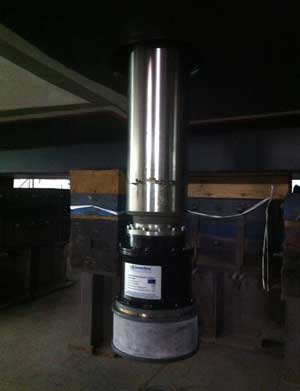 Through-Hull deployment
Through-Hull deployment
There are four types of deployment machine available, the first of these is our through-hull deployment machine. It consists of a hydraulically operated pole, a sealed bearing section and a sea chest service section with inspection door. The whole machine sits on a gate valve with the whole arrangement sitting on a through-hull penetration pipe.
Owing to its more complex nature and size, this set up is typically integrated into new build vessels. However, many have been retrofitted when there’s space.
Offshore Support Vessel Through-Hull deployment
The second type of deployment machine is a reduced size version of the through-hull deployment machine, specifically designed for offshore support vessels (OSV) where space is at a premium.
As a result, this deployment machine is intrinsically lower cost – without compromising on performance. The through-hull deployment machine uses an Inconel clad steel pole, for fantastic corrosion resistance. The OSV machine uses stainless steel pole providing good corrosion resistance, but at a lower cost.
Both machines can be controlled from a main control unit, local control unit or an optional bridge control unit as well as through Ranger 2 and Marksman. Both machines offer the option to have remote gate vale actuation.
These machines can be supplied to whatever type approval is required for your vessel, as well as type approved DN350 and DN500 gate valves.
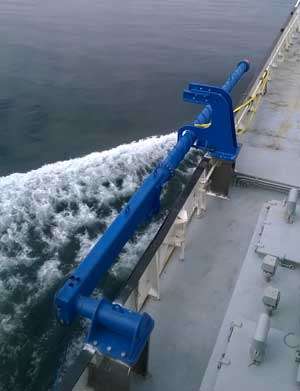
Going over the side
When cutting the hull is not an option we have our over-the-side deployment pole. This is the perfect solution for vessels of opportunity or smaller support vessels.
Made from high grade steel, the highly rigid pole has been designed with a helical strake running up its submerged section. This reduces the chance of vortex induced vibration, which can degrade system performance and lead to pole failure.
The pole is made from 3m sections allowing it to be adjusted in length for the vessel it’s being installed on. Typically, it’s supplied in a 9m or 12m length, with a deck mount pivot for easy access to the transceiver. For vessels where the drop between the deck and the water line is greater than 3m a hull-mount pivot can be supplied.
To protect the pole from corrosion it is made from hot dip galvanize steel coated in a two-part marine epoxy.
The deployment and recovery is left down to the vessel but this is typically done using the vessel’s crane or a third party winch fitted to the over-the-side pole.
 Through-tube deployment
Through-tube deployment
Our final type of deployment system is our through-tube deployment pole. This variation on the through-hull deployment machine has been designed for vessels where gate valves or over-the-side deployment are not viable or practical, due to size and space.
Just like the over-the-side pole, the through-tube pole also uses a helical strake to reduce the effect of drag and vibration. The same steel finishing processes are used here too. And, the through-tube pole can normally be retrofitted to most vessels.
If you’d like to know more about our deployment machine options or to discuss a particular project, please get in touch.
If you missed our video on deployment machine options, you can always watch it here.
By Geraint West – Global Business Manager, Oceanographic
From entire basin-wide acoustic monitoring systems to unmanned surface vessel (USV) survey and data gathering operations, great in-roads are being made into how much we know and are now able to learn about the oceans.
Some of these in-roads were shared at the 63rd Marine Measurement Forum (MMF), held last week.
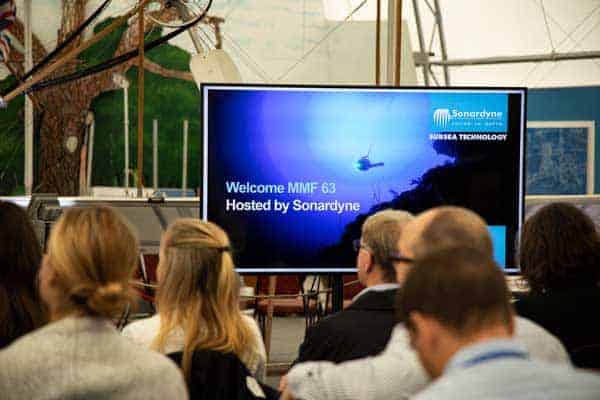
This fantastic non-profit and non-affiliated event, which we had the pleasure of organising and hosting at the at Farnborough Air Sciences Trust (FAST) museum, brought together people from across science and industry to discuss some of the latest initiatives and technologies in marine measurement.
About 60 attendees heard talks ranging from how we’re tracking sea-life and broadcasting to the world live from underwater submersibles to work that’s helping to clear plastic from the oceans.
Under particular focus was the increasing amount of work being done with USVs. But, it was also great to hear about basin-wide collaborative monitoring efforts and new sensor developments that will enable researchers and industry to sense more with single systems.
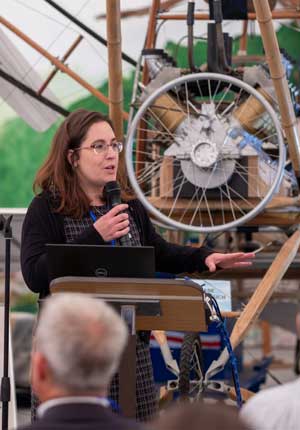 We want to thank all of the speakers who gave their time to share their work, including: the Nekton Foundation, AutoNaut, the National Oceanography Centre (NOC), Chelsea Technologies, the Centre for Environment, Fisheries and Aquaculture Science (Cefas), XOCEAN, Plymouth Marine Laboratory (PML), HR Wallingford, the National Physics Laboratory (NPL), R&V Hazelwood Associates and ourselves.
We want to thank all of the speakers who gave their time to share their work, including: the Nekton Foundation, AutoNaut, the National Oceanography Centre (NOC), Chelsea Technologies, the Centre for Environment, Fisheries and Aquaculture Science (Cefas), XOCEAN, Plymouth Marine Laboratory (PML), HR Wallingford, the National Physics Laboratory (NPL), R&V Hazelwood Associates and ourselves.
Our thanks also go to The Hydrographic Society whose Southern Region evening meeting, chaired by our very own Edd Moller, joined us at FAST following a locally supplied curry and drinks. The focus – The Fourth Industrial Revolution – with talks from XOCEAN and L3 Harris ASV, was a great follow-on from the talks we’d heard during the MMF.
We’re also hugely grateful to our venue, the truly fascinating FAST, which we got a chance to look around between talks. It’s well worth a visit for anyone interested in technology development, not just aeronautical. The museum’s archival material and built heritage date back to 1906 and include a 24ft wind tunnel and a raft of exhibits and aircraft, including a full scale replica of Samuel Franklin Cody’s aircraft – famed for having undertaken the first powered “controlled” flight in Britain.
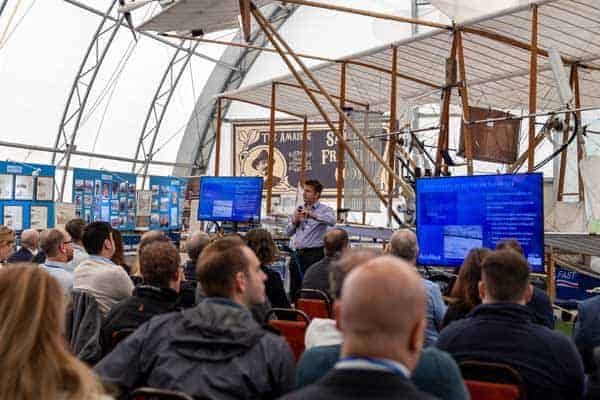 But, none of this would have been possible without those behind the MMF. In case you’ve not heard of the MMF, it’s a series of non- profit one-day events focused on the informal exchange of ideas, knowledge, techniques and developments across an extensive range of marine scientific measurement activities. It’s run by a volunteer committee and hosted on a volunteer basis.
But, none of this would have been possible without those behind the MMF. In case you’ve not heard of the MMF, it’s a series of non- profit one-day events focused on the informal exchange of ideas, knowledge, techniques and developments across an extensive range of marine scientific measurement activities. It’s run by a volunteer committee and hosted on a volunteer basis.
While we are making in-roads into what we know about our oceans, there’s still a long way to go. That’s why we’re already looking forward the next MMF, which will be hosted by The Hydrographic Society and in Plymouth in Spring 2020. Keep an eye on www.mmf-uk.org for details, or better still, sign up for the mailing list via the website.
Science equipment and underwater vehicles deployed from Brazil’s flagship oceanographic research vessel, Alpha Crucis, are to be tracked using Ultra-Short BaseLine (USBL) positioning technology supplied by Sonardyne Brasil Ltda.
The 64 m-long vessel, which is operated by the University of São Paulo, undertakes research projects spanning global climate change to biodiversity in Brazilian waters. It will be equipped with a Sonardyne Ranger 2 USBL high precision acoustic positioning system to enable the Alpha Crucis’ 21-strong science team to precisely track their instruments and sensors to beyond 7 km.
Ranger 2 accurately tracks the position of subsea targets by precisely measuring the range and bearing from a vessel-mounted transceiver to transponders on each target. The University of São Paulo has selected Sonardyne’s pre-calibrated Gyro USBL transceiver for the vessel and 4,000 m depth rated Wideband Sub-Mini 6 Plus (WSM 6+) transponders for its in-water equipment, which includes sediment corers, towed cameras, landers and remotely operated vehicles (ROV).
Gyro USBL is pre-calibrated thanks to its perfectly aligned acoustic transceiver and built-in attitude and heading reference sensor (AHRS). This combination eliminates the need for measurements to be undertaken to determine the alignment of the ship’s motion sensors to the acoustic transceiver. Survey operations are faster and more precise, helping to maximise the available vessel time for science.
[blockquote author=” Dr. Prof. Paulo Sumida, Vice-Dean, Oceanographic Institute of University of São Paulo”]”To gather meaningful data to support our studies, first our scientists need to know exactly where their sensors and equipment packages are in the ocean when they make their observations. With Ranger 2, they’ll be able to do just that. It came highly recommended by our colleagues in the international science community giving us every confidence to select it for the Alpha Crucis.”[/blockquote]
André Moura, Sales & Applications Manager from Sonardyne Brasil, says, “The university’s vessel operates from off the coast to the deepest parts of the South Atlantic so it’s important it’s equipped with the best available technologies available to underpin its important work. Ranger 2 Gyro USBL, deployed using our over-the-side deployment pole, is the perfect option for the vessel – it’s quick to install and pre-calibrated. Plus it gives the university the option to move the complete system to another vessel if the need ever arises.”
